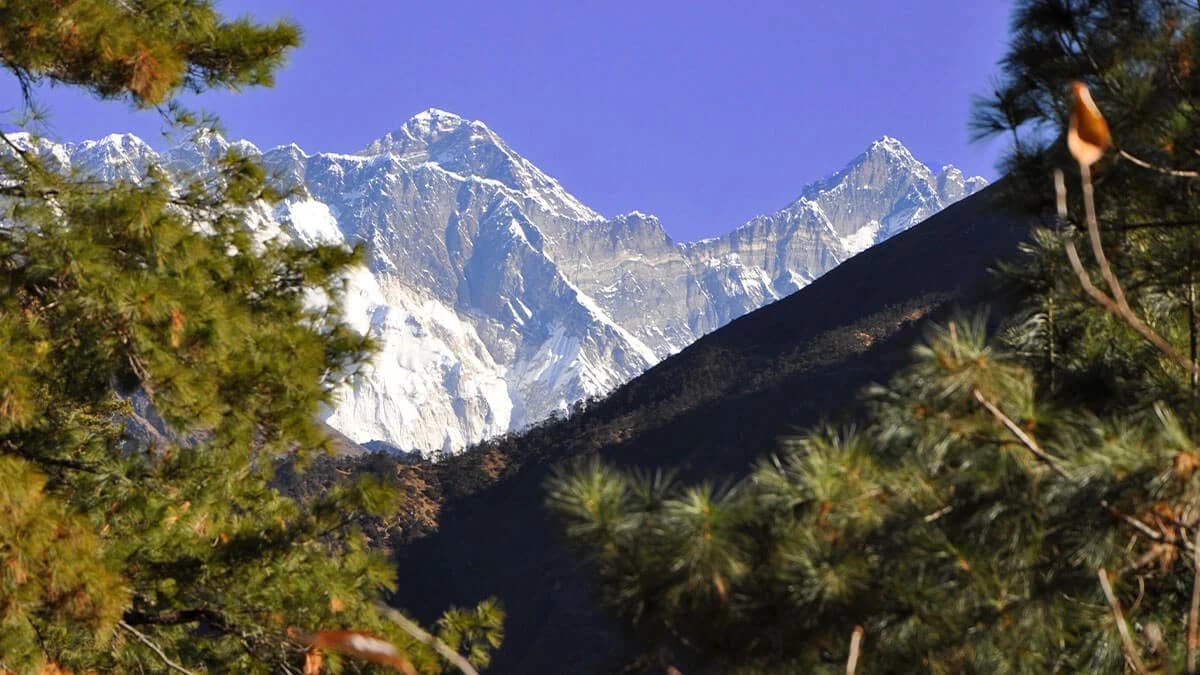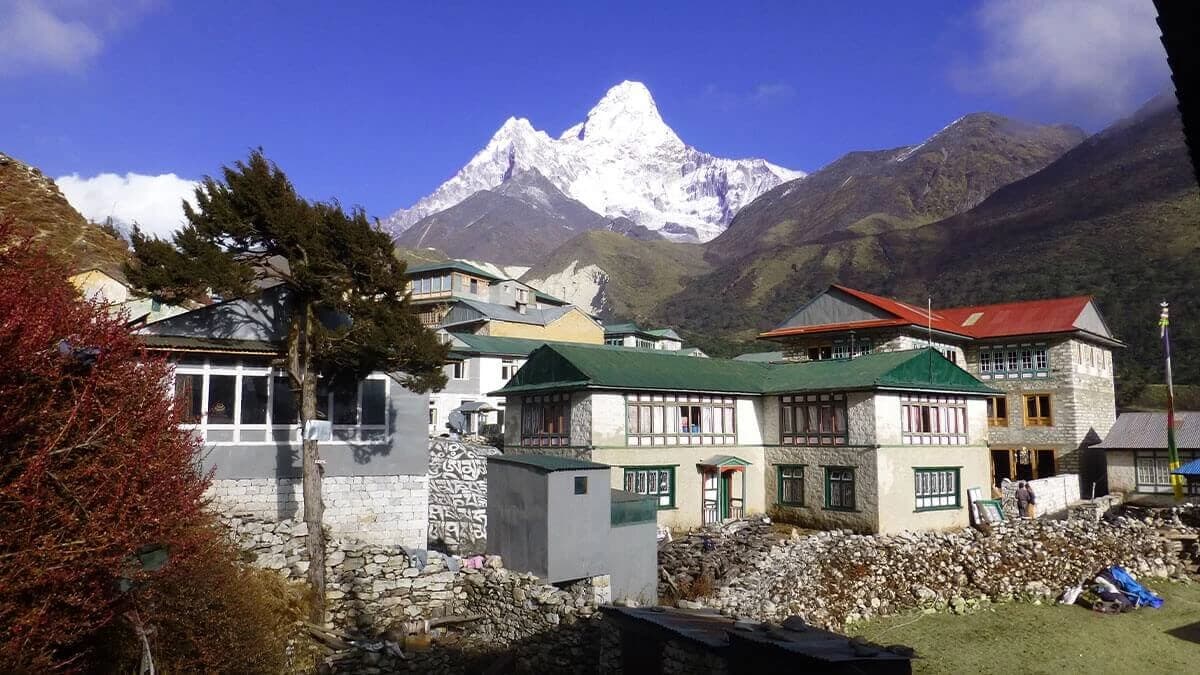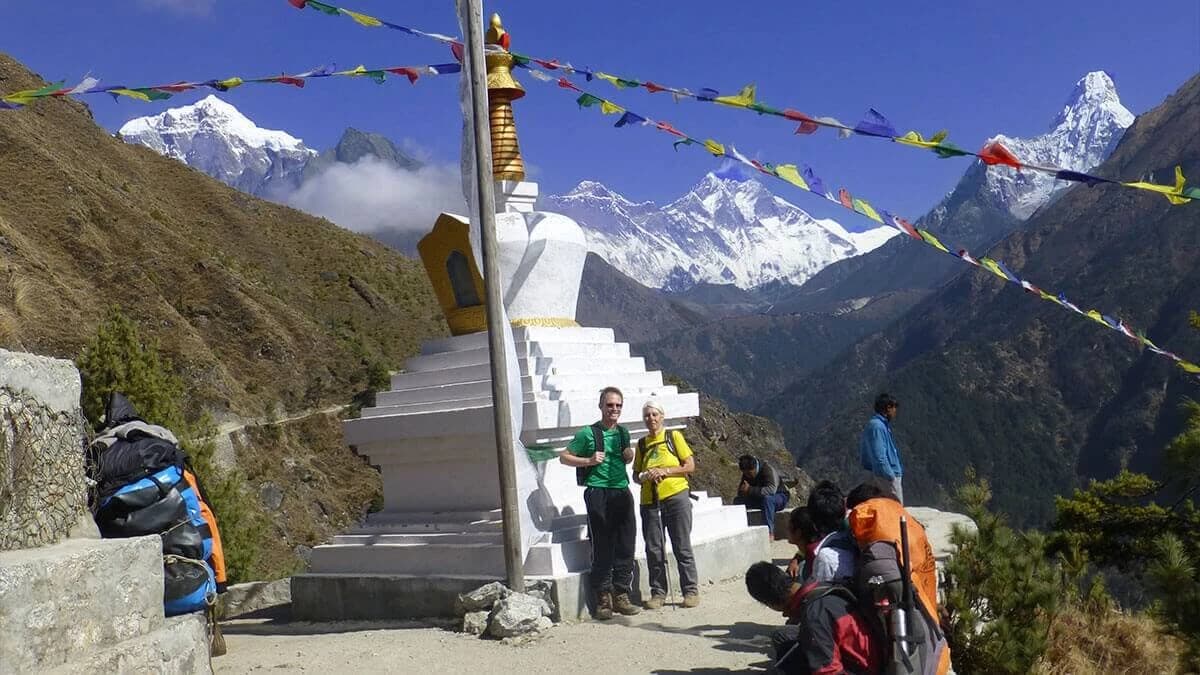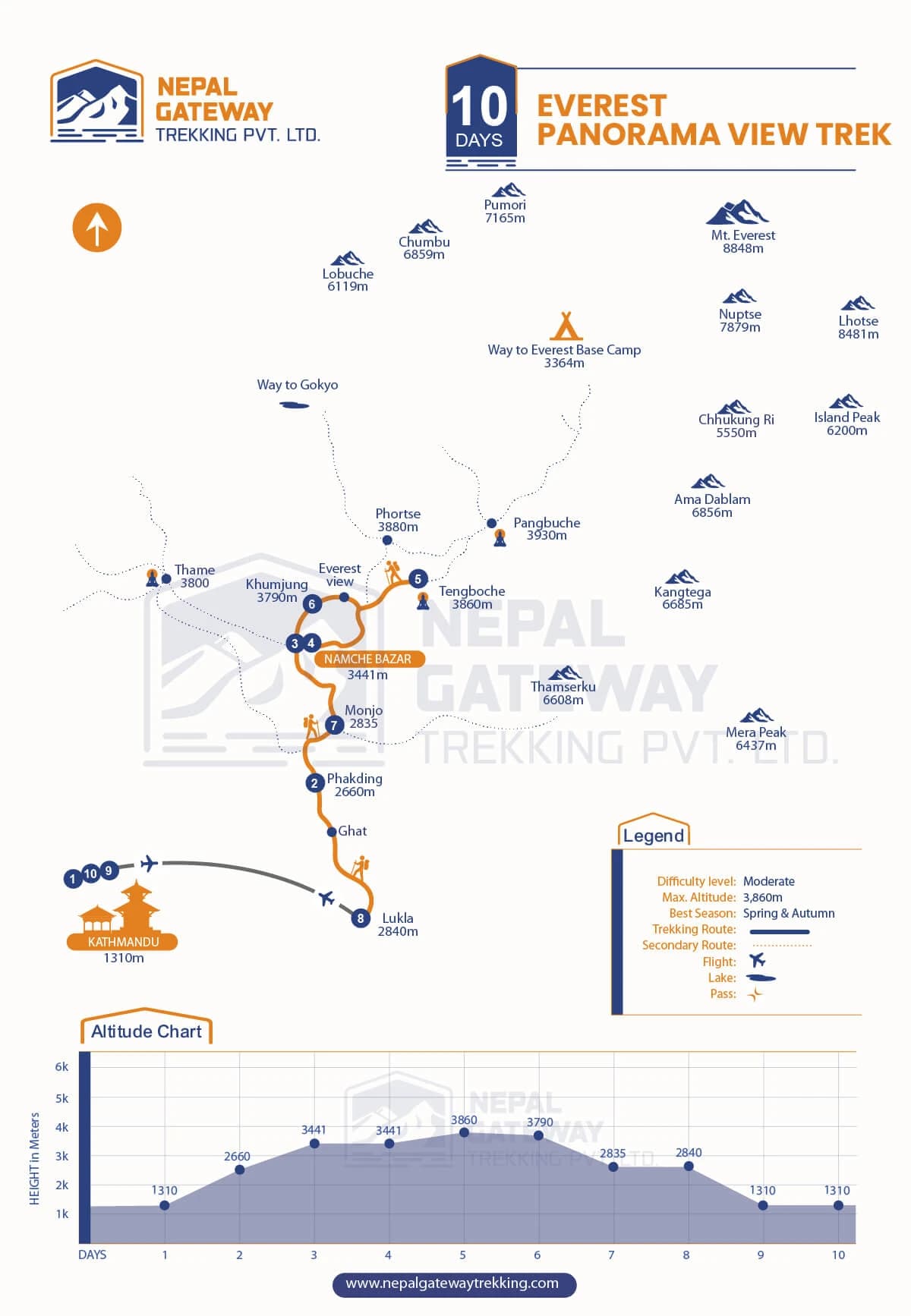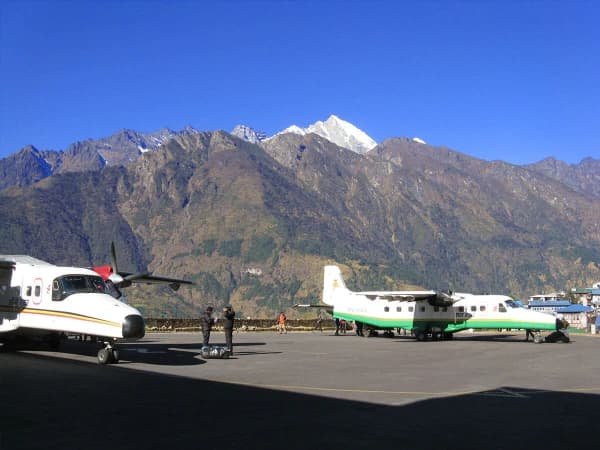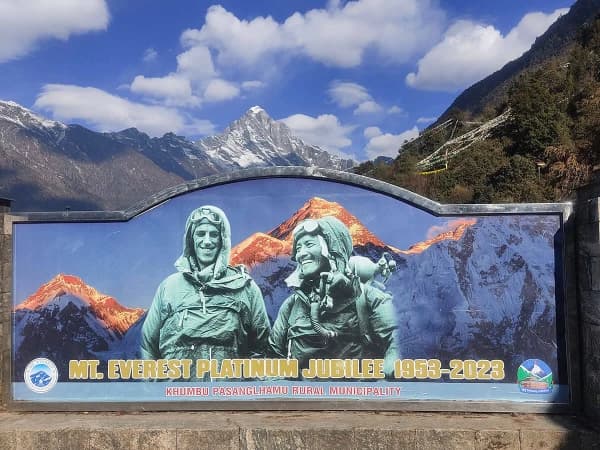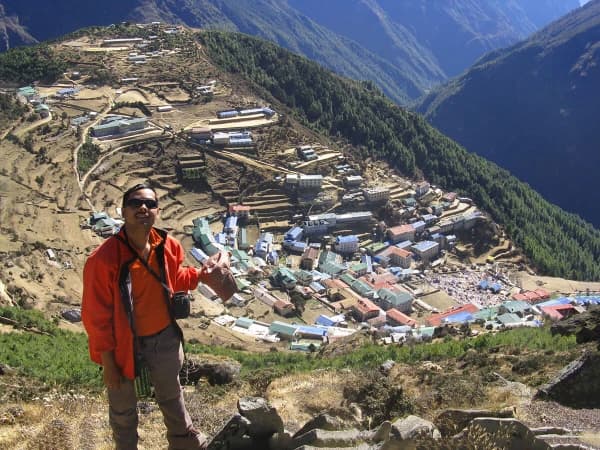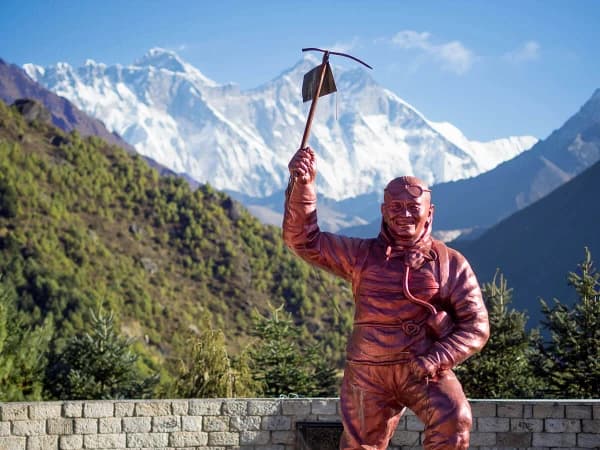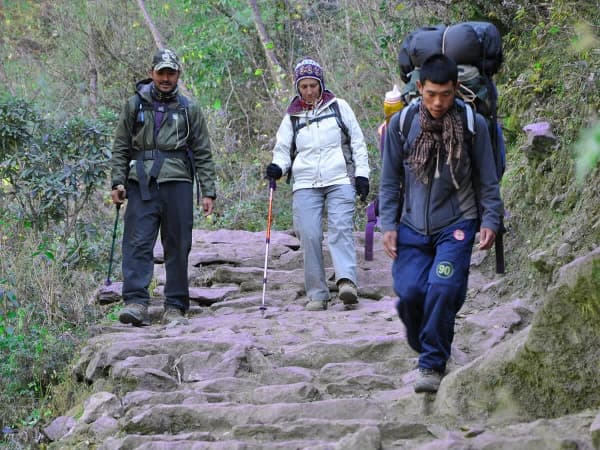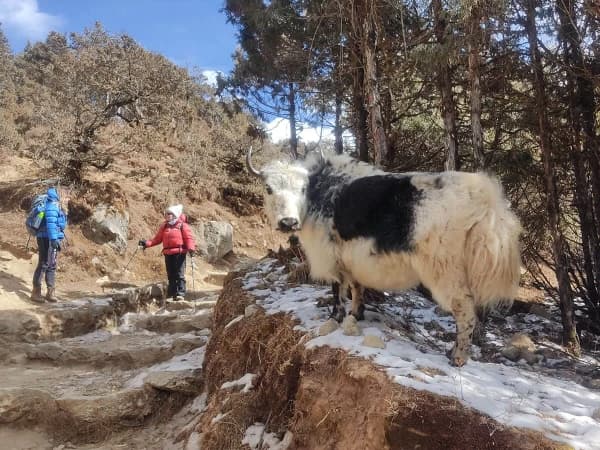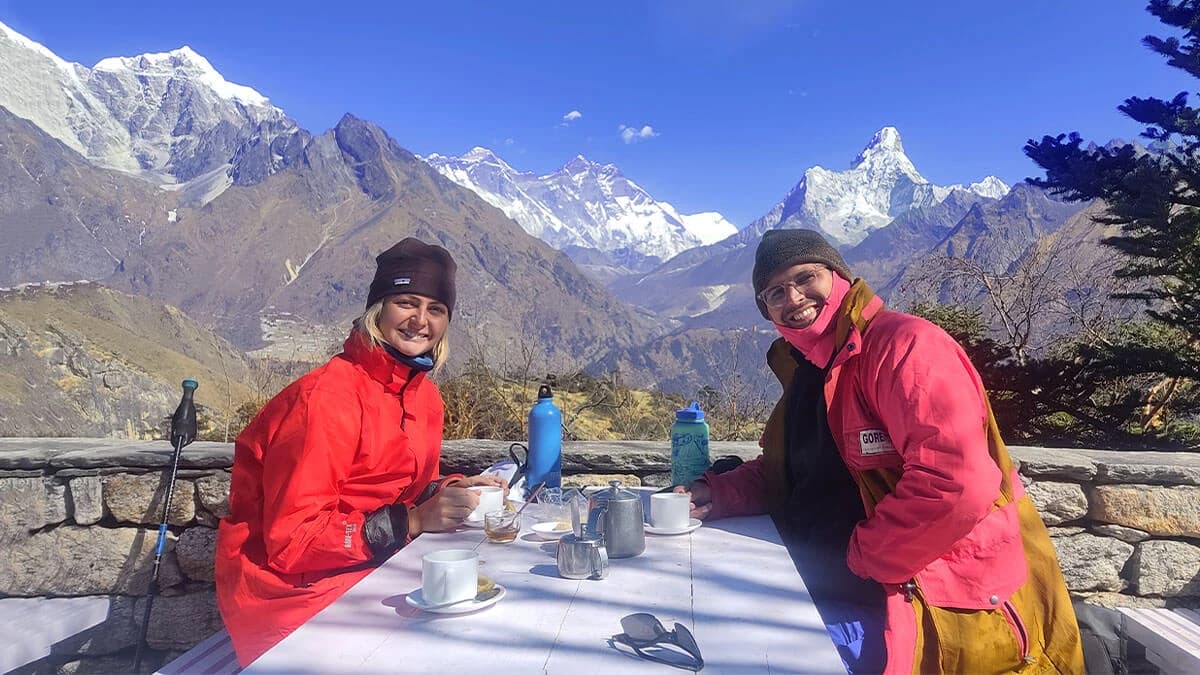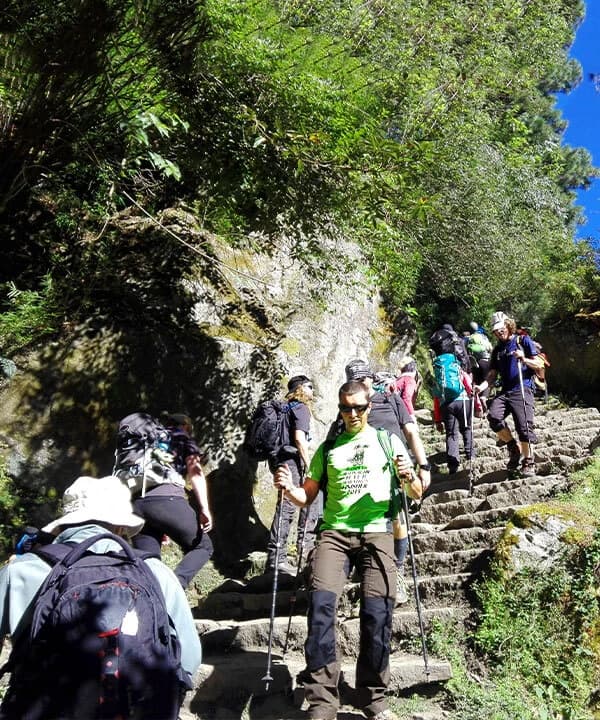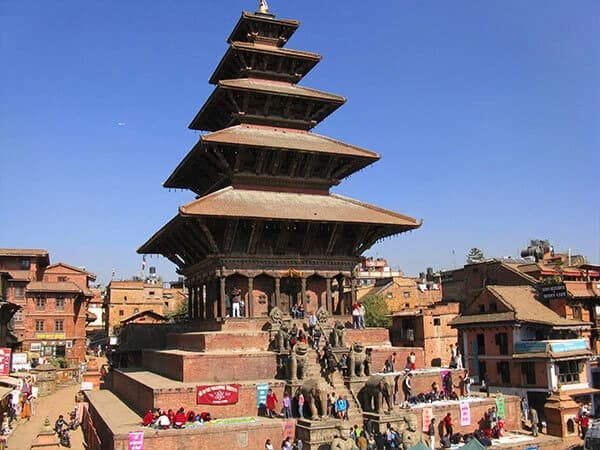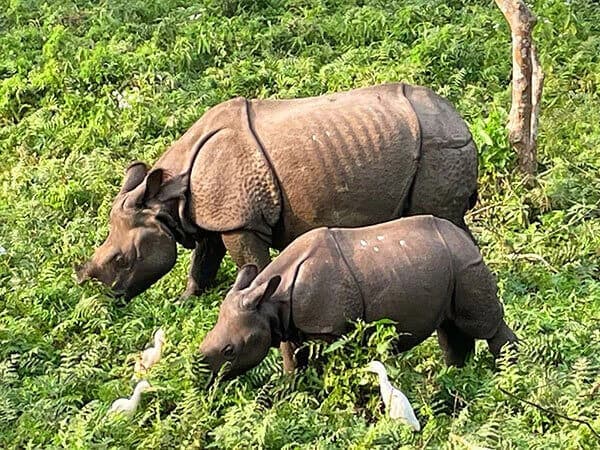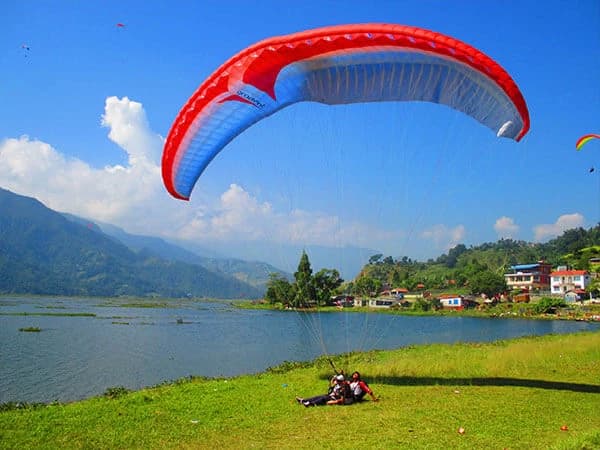Looking to see Mount Everest without being at a high elevation? The Everest Panorama View Trek is the perfect short trek to Everest. Join us for wonderful memories.
Everest Panorama View Trek
Everest Panorama View Trek is one of the best short treks in the Everest region. Although it does not take you to the base camp of Mt. Everest, this trek combines the whole Himalayan experience. This trek combines high mountain scenery, rustic Sherpa lifestyle, ancient monasteries, and fascinating cultural encounters.
Important Note: During the peak season, flights will be operated from Manthali Airport, Ramechhap, to Lukla. In the spring, from mid-March to mid-May and late September to November in autumn, all flights take off and land at Manthali Airport.
The Manthali airport, Ramechhap, is 142 km from Kathmandu, a 4-5 hour drive. To catch a flight to Lukla from Ramechhap, you must depart from Kathmandu from 1 a.m. to 2 a.m.
We highly recommend that you come with at least one more extra day for jet lag, especially considering the early morning drive to Manthali Airport, which benefits from adequate rest and sleep beforehand.
The Top Highlights of Everest Panorama View Trekking
- A short and easy walk in the heart of the Everest region.
- Fly to one of the most extreme airports—Tenzing-Hillary Airport in Lukla.
- Spend a day at the vibrant Sherpa capital of Namche Bazaar.
- Visit the Sherpa Culture Museum and the Everest Photo Gallery in Namche Bazaar.
- Explore the serene village of Khumjung and embrace its tranquility.
- Visit the ancient Buddhist monasteries of Tengboche and Khumjung.
- Relish the panoramic mountain view from Tengboche Monastery, including Mt. Everest and Ama Dablam.
- Enter one of the world’s highest national parks—Sagarmatha National Park.
Everest Panorama View Route Overview
This holiday begins with a dramatic 30-minute flight from Kathmandu (or Ramechhap, 18 minutes) to Lukla. After landing, you’ll start the trek on a gradual path on the riverbank of the Dudh Koshi River. Walking past a few small settlements, you’ll arrive at Phakding to conclude your first day of the trek.
On the second day, you’ll climb steeply from Phakding to reach the Sherpa capital of Namche Bazaar. You go for a short hike to the Sherpa Culture Museum and the Everest Photo Gallery on acclimatization day. You learn about the ancient culture and lifestyle of the Sherpas. You hike up to the Everest View Hotel with a stunning view of Mount Everest.
Beyond Namche Bazaar, you’ll take a scenic route towards the settlement of Tengboche. Here, you’ll visit Khumbu’s largest Buddhist monastery and receive blessings. Additionally, you’ll get to savor the close-up view of Ama Dablam. Mt. Everest, Nuptse, and Lhotse.
After exploring Tengboche, you’ll head toward the tranquil village of Khumjung. Here, you’ll visit another ancient Buddhist monastery and Khumjung Secondary School. Hereafter, you’ll start retracing the route back to Lukla via Monjo before concluding the trek with a flight back to Kathmandu.
The Everest Panorama View Trek serves as an excellent introduction to trekking in the Himalayas. This trek is suitable for all ages and experience levels. Although short, the steep ascents before Namche Bazaar and Tengboche can be exhausting for beginners.
Why Everest Panorama View Trek with Nepal Gateway Trekking?
- Our 10-day itinerary ensures an easy-paced journey, making it suitable for all age groups and experience levels.
- Professional trekking guide and Sherpa team with more than a decade of experience in the mountains to ensure proper navigation and valuable insights.
- A hassle-free experience as our team handles the logistics, trekking permits, and emergency response.
- A comfortable stay at a 3-star category hotel in Kathmandu on a BB basis.
- Accommodation at the finest teahouses in the Everest region, including all the meals (B/L/D) during the trek.
- Once you confirm the booking of this trip, Nepal Gateway Trekking will secure your flights to Lukla to improve your chances of getting the earliest flight.
- Free t-shirt and duffel bag from Nepal Gateway Trekking before the trek.
Itinerary
This is our standard and recommended Everest Panorama View Trek itinerary.
Upon your arrival, our representative will pick you up at Tribhuvan International Airport. He will transfer you to the hotel and help with the check-in formalities.
After checking in, you can take your time to rest and retrieve from jet lag or explore the nearby area in Thamel. In the afternoon, your trekking guide will meet you at the hotel lobby for an informal briefing about the trek. He’ll also check your gear and supplies to ensure you’ve packed all the essentials for the days ahead.
Note: We recommend you pack your luggage for the Everest Panorama View Trek on this day since you’ll leave early for the Lukla flight the next morning.
Your trekking guide will arrive at the hotel lobby early this morning. Then, drive to the domestic terminal of Kathmandu Airport (or Ramechhap) for Lukla. This short 40-minute flight is one of the major highlights of the Everest Panorama View Trek, offering a stunning view of the Himalayan ranges.
You will meet up with the rest of the trekking crew in Lukla before starting the trek. Today’s walk is short and gradual on the riverbank of the Dudh Koshi River. After crossing a few small Sherpa settlements like Chheplung, Koshigaun, and Ghat, you’ll reach Phakding to settle for the night.
Important Note: During the peak season, flights will be operated from Manthali Airport, Ramechhap, to Lukla. In the spring, from mid-March to mid-May and late September to November in the autumn season, all flights take off and land at Manthali Airport.
The Manthali airport, Ramechhap, is 142 km from Kathmandu, a 4-5 hour drive. To catch a flight to Lukla from Ramechhap, you must depart around 1 a.m. to 2 a.m. from Kathmandu.
On this day, you’ll enter the Sagarmatha National Park and reach the famous Sherpa capital of Namche Bazaar. You’ll begin the walk by crossing a suspension bridge over the Dudh Koshi River.
The walk alongside the river is relatively slow and delightful. After a few hours, you’ll pass the entrance to the Sagarmatha National Park at Monjo. Here, the officials will check and record the details of your permits.
After the permit check, you’ll gradually descend towards Jorsalle for the lunch stop. After crossing a few suspension bridges, the final section of the day is a two and a half-hour's climb to Namche Bazaar. This is one of the steepest sections of the Everest Panorama View Trek.
You’ll catch the first glance of Mt. Everest, a little over halfway line of this steep hill. Upon arrival at Namche Bazaar, you’ll check in at one of the finest lodges in the town to settle for the night.
On this day, you’ll take a much-needed break to acclimate your body before heading to Tengboche. After breakfast, you will go for a 20-minute hike to the Sherpa Culture Museum and the Everest Photo Gallery. This private museum displays an intriguing collection of ancient photographs and Sherpa artifacts.
After that, you can visit the Sagarmatha National Park Visitor Centre, which is a few minutes from the museum. This park centre has a life-size statue of Tenzing Norgay Sherpa. The small yard in front of the statue offers a breathtaking panorama of Mt. Everest, Ama Dablam, Thamserku, and Nuptse.
Depending on your condition, you also have the option to go hiking to the Everest View Hotel. But if you’re not up to it, return to the hotel and get some well-deserved rest.
Today, you’ll continue the trek on a pleasant trail through the rhododendron forest. With beautiful mountain views as a backdrop, this route is considered the most scenic in the Everest region.
Continue walking on the hillside above the Dudh Koshi River to reach Phungi Tenga. From here, the trail is steeply uphill for about two hours until you reach the small settlement of Tengboche.
Tengboche accommodates the largest Buddhist monastery in the Khumbu Valley. In the evening, you can visit this ancient monastery. The ridge outside the monastery offers a classic view of the Ama Dablam. Mt. Everest, Nutpse, and Lhotse.
Tengboche marks the highest elevation point of the Everest Panorama View Trek at 3,860 meters.
After breakfast, you’ll begin the trek with a steep descent from Tengboche towards Phunki Tenga. From here, the trail is relatively gradual until you reach the crossroad section of Kyangjuma.
Here, you’ll switch to a different route and head towards the village of Khumjung for an overnight stay. You can feel the calm and tranquil surroundings once you enter this small settlement. You’ll visit the ancient Khumjung Monastery and Khumjung Secondary School in the afternoon.
On this day, you’ll begin the return trek with a short day to the tiny hamlet of Monjo. At first, you drop down a small hill towards Namche Bazaar. Here, you’ll have enough time to sit down for coffee and buy souvenirs for your family and friends back home.
After a short break at Namche Bazaar, the trail descends steeply to the Dudh Koshi River. Following the downstream path, you’ll reach Monjo to settle in for the night.
From Monjo, the route continues to descend through dense pine forests by the Dudh Koshi River. Along the way, you’ll walk past several villages, including Benkar, Phakding, Koshigaun, and Chheplung, before arriving at Chaurikharka.
The final section involves a 45-minute steep climb until you reach the settlement of Lukla. In the evening, host a small party with your trekking guide and crew members to celebrate the end of the Everest Panorama View Trek. This is an ideal time to say goodbye to the trekking crew and thank them for making this trek a success.
On this day, you’ll leave the mountains behind and catch an early morning flight to Kathmandu. This is an excellent opportunity to glance out of your airplane window and enjoy the beautiful view of the mountain range one last time on this holiday.
Upon landing at Tribhuvan International Airport, our tour officer will pick you up from the domestic terminal and transfer you to the Woodapple Hotel and Spa (or a similar hotel) in Thamel.
You’ll have a free day in Kathmandu to rest and soak in the memories of the past week in the mountains. If you like it, you can walk around Thamel and buy souvenirs for family and friends.
A representative from Nepal Gateway Trekking will transfer you to the departure terminal of the Tribhuvan International Airport. Keep your bags and luggage ready, as we will schedule the pick-up three and a half hours before your flight.
Dates & Availability
Private tripCost Includes
- All grounded transportation by private vehicle as per group size.
- Two nights' accommodation at a three-star category hotel in Kathmandu, inclusive of breakfast.
- Round-trip flight ticket (Kathmandu/Lukla/Kathmandu or Ramechhap/Lukla/Ramechhap) inclusive of domestic airport taxes.
- Three meals (breakfast/lunch/dinner) on the trek.
- Twin-sharing common room accommodations during the trekking.
- One highly experienced government license holder, an English-speaking trekking guide.
- Required porters (1 porter between 2 trekkers). A porter is not included for solo trekkers.
- Sagarmatha National Park permit.
- Local government permit.
- Everest Panorama View Trekking Map.
- Nepal Gateway Trekking Company T-Shirt.
- Local fresh fruits (apples, oranges, pomegranates, etc.).
- First aid kit with oximeter to check heartbeats and oxygen levels regularly.
- Rescue assistance if it is needed during the trek.
- All government taxes.
- Office service charges.
Cost Excludes
- Lunches and dinners in Kathmandu.
- Travel medical insurance (compulsory).
- International flight ticket to/from Kathmandu.
- Nepal Visa.
- All kinds of hot drinks (tea/coffee/hot water) on the trek.
- Cold drinks (Coke/Fanta/mineral water) and alcoholic beverages on trekking.
- Your personal nature expenses, equipment, and medical kit.
- Hot shower, internet, battery charging, and snacks.
- Cooked desserts such as apple pie, chocolate bars, etc.
- Tipping to guides and porters (it is expected, not mandatory).
- Extra accommodations in Kathmandu.
Good To Know
What is the Standard Cost for the Everest Panorama Trek?
The standard cost of a 10-day Everest Panorama Trek is USD 1090. This cost includes Lukla’s airfare, necessary permits, a guide and porter. It also includes 3-star accommodation in Kathmandu, 7-night accommodation in local teahouses, and so on.
However, the cost of the trek depends on several factors, such as the group size, accommodation, service standards, and season. Hence, you can customize this trip to suit your needs and budget.
If you opt for luxury without worrying about the budget, we can arrange high-standard rooms throughout the trek. The room with heated blankets, full bedding, and ensuite bathrooms. Moreover, we can arrange a chartered helicopter flight from Kathmandu to Lukla to avoid the hassles and possible delays.
However, you can reduce the price by removing a few extra services for a budget-friendly option. You can choose a porter-guide option instead of a separate guide and porter. Please write to us your with plans and preferences, and we will make the adjustments to the trip accordingly.
Note: You must carry extra money (besides the package cost) for additional expenses during the trek.
Detailed Information on Lukla’s Flight
Kathmandu to Lukla Flight
Flying directly from Kathmandu is hands down the most convenient way to reach Lukla on a commercial flight. It takes around 30 minutes to get to Lukla from the capital city of Nepal.
However, the flight between Kathmandu and Lukla does not operate routinely during the trekking season. In recent years, all the commercial flights to and from Lukla have been diverted to Manthali Airport in Ramechhap.
The airline companies occasionally require aircraft flown to Kathmandu for maintenance or crew rotation. Additionally, most of the first flights to Lukla operate from Kathmandu Airport. Hence, you can get to Lukla directly from Kathmandu if you book a flight during these exceptions.
Note: During the off-seasons (winter and monsoon), commercial flights to Lukla are operated directly from Kathmandu.
Manthali to Lukla Flight
As mentioned, all commercial flights to and from Lukla have been operated via Manthali Airport in recent years. Hence, the Manthali Airport in Ramechhap has become one of the busiest domestic airports during the peak seasons.
It takes approximately four to five hours drive from Kathmandu to Ramechhap. Although the drive is an uninvited hassle, it is a more reliable option to fly to Lukla. Considering the distance between Manthali and Lukla (18 to 20 minutes on a flight), there’s a possibility of operating more flights in a short span.
If your adventure holiday is scheduled in the peak seasons (autumn and spring), Nepal Gateway Trekking will arrange private transportation to drive you from Kathmandu to Ramechhap. For this, your trekking guide will receive you at your hotel lobby at 2 AM. Upon reaching Manthali, we’ll ensure you catch the earliest flight to Lukla.
Helicopter Option
Another alternative to reach Lukla is to charter a helicopter directly from Kathmandu. If money is not your concern, this is the best way to avoid the five-hour drive to Manthali. Unlike the previous two options, this 45-minute ride on a chartered helicopter is the most luxurious way to reach Lukla.
Compared to commercial flights, helicopters are more reliable, comfortable, and safe. Moreover, they can fly even in bad weather, making delays less frequent.
If you decide to take the helicopter option, inform us in advance. So we can make the booking before you arrive in Nepal.
Flight Delays and Cancellations
Due to the airstrip’s location, weather, elevation, and air traffic, flights to and from Tenzing-Hillary Airport in Lukla are prone to delays and cancellations. Although the mornings are often clear, Lukla’s weather and visibility change rapidly with thick cloud covers and strong tailwinds.
The sudden change in weather makes it difficult for airline companies to maintain their flight schedules on time. Compared to other seasons, delays and cancellations are more frequent in the monsoon and winter seasons due to the rain clouds, strong winds, and dense fog.
Besides that, Lukla flights were often delayed and canceled due to runway congestion at Kathmandu Airport. Hence, in the last few years, flights to and from Lukla have been operated from Manthali Airport during the trekking seasons. Although it is inconvenient to drive from Kathmandu to Manthali, it is a more reliable option to avoid delays and cancellations in Lukla.
Despite that, delays and cancellations in Lukla are inevitable. So, we strongly suggest all our clients add at least one buffer day to your itinerary.
Everest Panorama View Trek Permit
You only need to acquire two permits for the Everest Panorama View Trek.
1. Khumbu Pasang Lhamu Rural Municipality Permit
The first permit you need for the Everest Panorama View Trek is the Khumbu Pasang Lhamu Rural Municipality Permit. This trekking permit is imposed by the local government of Khumbu, replacing the TIMS Card in the region.
You can get this trekking permit from the checkpoints at Lukla or Monjo. Unlike other trekking permits, you can not obtain Khumbu Pasang Lhamu Rural Municipality Permit from Kathmandu. The cost of this permit is Rs. 3000 for all foreign travelers.
2. Sagarmatha National Park Permit
Another permit you need to acquire for the Everest Panorama View Trek is the Sagarmatha National Park Permit. You need this permit to enter the protected areas of Khumbu.
You can obtain this permit from the entrance gate of Sagarmatha National Park in Monjo or the Nepal Tourism Board office in Kathmandu. The park entry permit costs Rs. 3000 for foreign travelers and Rs. 1500 for SAARC nationals.
How difficult is the Everest Panorama View Trek Route?
The Everest Panorama View Trek Route is moderately difficult. Unlike the Everest Three High Passes Trek, it does not require climbing high mountain passes or walking through technical sections.
Hence, the Everest Panorama View Trek suits all ages and experience levels. However, there are a few steep ascents on the way to Namche Bazaar and Tengboche, which might be exhausting for beginners.
The route is relatively easy for experienced trekkers. The trails are well-maintained and marked with sign boards and route markers.
The highest elevation point of the Everest Panorama View Trek is 3,860 meters at Tengboche. Although it does not seem that high, it is high enough to cause altitude sickness. So, drink as much water as possible and walk at the most comfortable pace to avoid it.
Since this is a multi-day trek in the Himalayas of Nepal, you need to be fit enough to walk at least 5 to 6 hours daily on rough terrain. Hence, we recommend you train at least 6 to 8 weeks before the trek to build physical endurance and mental resilience.
Training for Everest Panorama View Trekking
Although the Everest Panorama View Trekking is a short and moderate walk, it requires decent physical fitness, stamina, and mental strength. If you’re planning to sign up for this adventure holiday, starting a basic training program to prepare your body to walk on rough terrains while carrying a backpack is a good idea.
Although you do not require extreme training, here are a few simple ways to train for the Everest Panorama View Trek:
Go For A Hike
One of the best ways to train for the Everest Panorama View Trek is to go on short hikes in the hills near your town. Find a similar trail and walk 5 to 6 hours weekly with brief breaks to build endurance and stability.
We suggest you wear hiking boots and carry a loaded backpack during these hikes to get used to the extra weight in the mountains. If there aren’t any hills around your hometown for hiking, you can go for a long walk around the city or climb up and down the stairs regularly.
Cardio Workout
Building cardiovascular fitness is arguably the most critical aspect of Everest Panorama View Trek training. Given the long hours of walking and high altitude, a great mix of cardio workouts helps improve breathing and prepare the body to function better with less oxygen.
To build cardiovascular fitness, you can combine exercises like jogging, cycling, running, swimming, and jumping ropes. We suggest you start slow and gradually improve your workouts’ duration, frequency, and intensity (at least four days a week).
Gym Workout
Join a gym and start working out on your strength! As mentioned, a few exhaustingly steep ascents on the trek require a strong body — the core, leg muscles, and back muscles, in particular.
Here are a few gym workouts to include in your training regimen:
- Jump Squats - 15 to 20 repetitions
- Glute Bridge & Hamstring Curl - 10 to 15 repetitions
- Step-Ups - 15 to 20 repetitions on each leg
- Kettlebell Deadlifts - 5 to 6 repetitions
- Stairmaster for 20 minutes
- Downhill Lunges - 15 to 20 repetitions on each leg
- Side Plank with Leg Raise - 10 to 15 repetitions on each side
Remember, you must maintain the correct posture and form during these gym exercises to prevent injuries. If you do not have prior experience, we suggest you start training under a professional trainer.
Stretching Exercises
Stretching exercises and yoga practices help improve joint flexibility and reduce the risk of cramps and injuries. They can also help you warm up before trekking and relieve muscle soreness after trekking.
Some of the best stretching exercises before trekking are
- Shoulder Rolls
- Calf Stretch
- Standing Quad Stretch
- Wrist Stretch
- Hamstring Stretch
Some of the best stretching exercises after trekking are
- Ankle Stretch
- Standing Saddle Stretch
- Runner’s Lunge
- Rag Doll Pose
When is the Best Time for the Everest Panorama View Trek?
While most people recommend the autumn and spring seasons, the Everest Panorama View Trek is accessible year-round. Each season brings unique elements to this part of the world.
Autumn (September to November)
Autumn is hands down the best time for the Everest Panorama View Trek. During this time of the year, the weather is dry, and the skies remain bright and clear. This is the best time to relish the mountain panorama from Tengboche.
If you schedule your holiday around October, you can witness the grand celebration of the Mani Rimdu festival in the monastery of Tengboche. Besides that, the chances of flight delays and cancellations are also significantly lower in autumn.
Since this is the most popular trekking season, the only downside is the crowded trails and packed lodges.
Spring (March to May)
Another popular time for the Everest Panorama View Trek is the spring season. During this season, the rhododendrons and primroses surround the entire route, adding more colors and vibrance.
Spring seasons offer warm mornings, sunny afternoons, and extended daylights. Hence, you’ll likely get mountain views from morning to early afternoon. The late afternoons usually bring thick cloud cover, blocking the entire sky and the view.
Like autumn, the route and teahouses will be flooded with trekkers and climbers.
Winter (December to February)
Unlike other high-altitude treks, the Everest Panorama View Trek is accessible in winter. Although the temperature may be too extreme, clear skies and empty trails accompany it.
The beautiful town of Namche Bazaar, covered in thick snow, is a rare sight most trekkers do not get to relish. The early and late hours of the winter season are cold, while the midday temperature is tolerable. Since the days are relatively short, we recommend you keep your walks shorter and reach your overnight destination before sundown.
Remember, the risk of altitude sickness, hypothermia, and sunburn is relatively high in winter. So, pack your gear meticulously before starting the trek.
Monsoon (June to August)
Monsoon is the least favorable time for Everest Panorama View Trek. During this season, the mornings are often bright and clear. However, the weather changes dramatically in the afternoon with thick cloud covers and rain showers.
You must be extra cautious during the monsoon season. The steep slopes to Namche Bazaar and Tengboche can get extremely slippery. Also, you might have to pack and be prepared for constant rainfall throughout the day.
Regardless, monsoons bring colorful flowers and greenery. Different flowers surround the trekking route, including white edelweisses, rhododendrons, yellow cinquefoils, and blue poppies. Besides, you’ll have the empty trails all for yourself during this time of the year.
Acclimatization and Safety
On Everest Panorama View Trek, you will walk up to 3,860 meters at Tengboche, starting at 2,860 meters at Lukla. Unlike Everest Base Camp Trek or Gokyo Valley Trek, which deals with an elevation of over 5,000 meters, the risk of high-altitude sickness in this trek is significantly less.
The 10-day Everest Panorama View Trek itinerary also ensures slow-paced trekking with an acclimatization day at Namche Bazaar.
Having said that, you should not neglect this aspect whatsoever. Altitude sickness can occur at elevations as low as 3,000 meters if you’re not careful enough. So, letting your body acclimatize to the thin air is essential to prevent high-altitude sickness on Everest Panorama View Trek.
Things You Should Do for Acclimatization
- Walk gradually at a comfortable pace to let your body adjust to altitude naturally.
- Once you’re above 3,000 meters, limit your daily altitude gain to less than 500 meters.
- Drink at least 3 to 4 liters of fluid regularly. Try meeting this goal with water only. If you still need to, you can drink hot drinks and soups to add up.
- Keep your body warm and protected from the harsh wind. Carry a windstopper or fleece jacket to protect yourself from the afternoon winds, especially after you reach Namche Bazaar.
- Losing appetite at such elevations is common due to the decrease in oxygen level. However, you must consume enough nutrients and calories each day to fuel your body.
- Packaging acetazolamide (or Diamox) in your backpack is advisable for preventive use.
Things You Should Not Do for Acclimatization
- Stay away from alcohol or other stimulants throughout the trek.
- We advise you not to sleep during the day. You will likely feel tired and sleepy, but stay active with afternoon walks or board games.
- Never take sleeping tablets to fall asleep in the mountains. If you have pre-existing conditions, consult a doctor before taking any medications.
- If you feel any symptoms of high-altitude sickness, do not hide it from your trekking guide. Communicate the problem so they can take necessary action immediately.
How Do We Help Our Clients Acclimatize?
The safety and security of all our clients have been the number one priority for Nepal Gateway Trekking. Hence, we consider several factors to ensure proper acclimatization during the Everest Panorama View Trek, even though the risk is minimal.
The 10-day itinerary of the Everest Panorama View Trek includes an acclimatization day at 3,440 meters at Namche Bazaar. On this day, you’ll take a short hike to the Sagarmatha National Park Visitor Centre to help your body adapt to a higher altitude before heading to Tengboche.
After reaching Namche Bazaar, your daily altitude gain will be under 500 meters. Besides that, our trekking guides and leaders have over a decade of experience in high-altitude expeditions. They are professionally trained for Wilderness First Aid (WFA). They will monitor your health condition regularly and take necessary actions to help you avoid high-altitude sickness.
Accommodations
You’ll stay at Woodapple Hotel and Spa (or a similar hotel) in Kathmandu. Located in the heart of Thamel, this 3-star hotel offers several first-class amenities, such as luxurious rooms, a rooftop restaurant, and a spa center.
During the trek, you will stay in a typical Sherpa teahouse on a twin-sharing basis (paired up with someone of the same gender). Unlike other remote treks, Everest Panorama View Trek has well-maintained teahouses throughout the route. Out of them, Nepal Gateway Trekking handpicks the best option possible to ensure our clients get the best rooms after a long day of trekking.
The bedrooms are cozy and comfortable, with a small wooden bed, pillows, foam mattresses, and warm blankets. Most teahouses in this region do not offer attached toilets unless you go for more luxurious options. Although you’ll have to share the toilet, they are kept clean in all teahouses.
The dining area is usually the busiest, as most trekkers use it for meals and relaxation. A small fireplace in the middle, fueled by dried yak dung, keeps the dining area warm.
Meals
The teahouses and restaurants of Everest Panorama View Trekking provide multiple food choices, from local dishes to continental cuisines. However, Dal Bhat (rice, lentils, and vegetables) is the staple meal among the trekkers. Other popular options include momo, thukpa, chowmein, yak steak, spaghetti, and hot soup.
Nepal Gateway Trekking will provide all three meals (breakfast, lunch, and dinner) during the trek. We recommend that you avoid meat and opt for vegetarian options.
The teahouse and restaurants offer a variety of beverages. Some familiar names on the menu are milk tea, ginger tea, black tea, black coffee, hot lemon, hot chocolate, and hot juice. Moreover, a few cafes and hotels in Lukla, Phakding, and Namche Bazaar also serve machine-brewed coffee, including Espresso, Americano, Cappuccino, and Cafe Latte.
Drinking Water Supplies
The local teahouses offer tap, boiled, and bottled water throughout the trail. You can fill the tap water from the kitchen or find local taps along the route. But you should never drink untreated tap water directly from their sources. Carry purifying tablets or filters to treat tap water before drinking.
Boiled water is the safest option for keeping your body hydrated without risk of water-borne diseases. Moreover, boiled water helps with sore throat, blood circulation, and digestion. So, carry a water bottle or a hydration pack and refill it in the teahouses.
Also, we do not recommend buying bottled water due to the environmental concerns and cost.
Hot Shower facilities
Everest Panorama View Trek is perfect for those who prefer to treat themselves with a hot shower daily. Unlike remote treks, hot showers are available in every hotel and teahouse from Lukla to Tengboche. However, you’ll have to pay an extra few dollars for a hot shower.
Almost every teahouse we sleep in provides gas, electric, or solar-powered hot showers, so most offer running hot water. Depending on the location, a hot shower may cost around $2 to $8.
Mobile Network and Internet Connectivity
Mobile networks are exceptional in every section of the Everest Panorama View Trek. Unless there are technical issues, both NTC and Ncell services work fantastic up to Tengboche. However, mobile data is extremely slow and unreliable in the mountains.
Most local teahouses in this trek provide WiFi services for a small fee of $4 to $7 per user. The internet connection is fast and reliable most of the time. However, it might get a bit slow on a busy day with many users.
Electricity
Electricity is available throughout the Everest Panorama View Trek. Every teahouse from Lukla to Tengboche is powered by a mini-hydroelectric station. So, charging your phones and other electrical devices will not be a problem on this trek.
Most teahouses, except for a few high-end hotels, do not have charging sockets in the rooms. They often have a common charging station at the counter of the dining area with a huge multi-plug.
The most common types of charging sockets in Nepal are two-round or three-round prongs. If your charger has a different plug, it is advisable to buy an adapter in Kathmandu before the trek.
Note that you’ll have to pay extra to charge your devices. As you go higher, the charging cost will likely be more expensive. Also, the price may vary on the device you’re charging. Although charging is not an issue in this trek, we suggest you bring a high-capacity power bank to charge your mobile devices and carry spare camera batteries just in case.
ATMs and Money Exchange
While in the mountains, most teahouses and shops only accept local currency, i.e., Nepalese rupees. It is a good idea to exchange your foreign currency for local rupees before the trek.
The most reliable place to exchange currency is in Kathmandu. There are plenty of money exchange centers in Thamel. We recommend you exchange a few smaller bills to avoid the hassle during smaller transactions.
Likewise, if you wish to withdraw some cash for the trek, do so in one of the ATM booths in Kathmandu. Although there are a few ATMs in Lukla and Namche Bazaar, they are not as reliable.
Travel Insurance
Although the Everest Panorama View Trek is moderately challenging, it involves the risk of altitude sickness and physical injuries. On rare occasions, you might even require helicopter evacuation from the trail directly to the hospital in Kathmandu.
So, it is mandatory to have a valid travel insurance policy to join this adventure holiday with Nepal Gateway Trekking. When buying the insurance policy, make sure it covers the cost of medical treatment, trip cancellation, and helicopter evacuation in 4,000 meters.
Guide and Porter Information
Guides, porters, and other crew are crucial members of any trek. Therefore, Nepal Gateway Trekking will provide a professional and qualified trekking guide to lead your Everest Panorama View Trek.
With over a decade of experience in the mountains, our guide will ensure safety and proper navigation throughout the trek. Moreover, they are certified by Wilderness First Aid (WFA), which means they are fully trained to provide first aid assistance in high altitudes.
Our trekking guide will be assisted by an experienced team of Sherpas and porters.
Gratitude for the Trekking Crew
Tipping is a common way to express gratitude for your trekking crew. Although it is not mandatory, it is a courteous act to support the income of the crew. Typically, the guides, porters, and other staff are offered tips on the farewell party in Lukla.
We recommend that you collect the tip money as a group and hand it over to the trekking guide. Later, the guide will divide the amount equally among all the members at the final day ceremony.
Another way to support the crew is by donating used trekking gear. In Nepal, porters and other staff will happily receive any gear you offer them—hiking boots, hats, shirts, poles, jackets, etc. If there’s someone specific you think deserves the gear, you can give it to him/her directly or collect it and ask the guide to distribute it fairly.
Packing List for Everest Panorama View Trek
Clothing
- Breathable Trekking Shirt
- Trekking Trousers/Leggings
- Warm Trousers (for Evenings)
- Trekking Shorts
- Thermal Baselayer
- Fleece Jacket
- Down Jacket
- Waterproof Shell Jacket
- Waterproof Trouser
- Breathable Underwear
- Sports Bra (For Women)
Footwears
- Hiking Boots
- Sandals/Trainers
- Hiking Socks
- Thermal Socks
Head Gear
- Sun Protection Hat/Cap
- Beanie
- Buff/Neck Gaiter
- UV Protection Sunglass
- Headlamp (with Spare Batteries)
Hand Wear
- Woollen Gloves
- Hard-Shell Outer Gloves
Bags
- Duffel Bag
- Day Pack
Other Essentials
- Trekking Poles
- Microfibre Towels
- Water Bottle
- Water Purification Tablets
- Toiletries
- Sunscreen
- Lip Balm
- Hand Sanitizers
- Passport
- Copies of Passport-Sized Photos
- Power Bank
- Personal Medications and First Aid Kit
- Camera or Go Pro
- High Protein Snacks and Bars
FAQs
Everest Panorama View Trek is one of the moderate treks in the Everest region. Its maximum elevation is 3,860 m. The trail to Everest View Trek is lovely and well-maintained. Because of these aspects, Everest Panorama Trek is very friendly for beginners and families with children.
The best viewpoints to see Mount Everest (8,8848 m) during the Everest trek are Namche Bazaar, Syangboche Airport, Everest View Hotel, and Tengboche Monastery, respectively. These places offer an incredible view of the world's tallest mountain, Mount Everest, with its neighbouring peaks.
The standard cost for doing the Everest View Trek starts from USD 1120. The price is mainly dependent on the services you want to use on the package.
The difficulty level of the Everest Panorama View Trek is easy to moderate. The highest elevation of this trek is 3,860 m. However, it is not a high-altitude trek in the Everest region; there are several ups and downs. There are two main steep climbs while reaching Namche Bazaar and Tengboche Monastery.
Yes, you can book a private trip for the Everest View Trek. We organize private trips for solo trekkers, couples, and families.
Everest View Trek is not high-altitude trekking among other Everest trekking routes. There is minimal chance of getting altitude sickness during the Everest View Hike. You only get AMS if you push yourself to reach Tengboche Monastery (3,860 m) in two days.
You do not reach Everest Base Camp during the Everest Panorama View Hike. You only reach up to Tengboche Monastery. You need at least four more days to reach EBC from Tengboche. Everest Panorama Hike is a short hike in the Everest region around Namche Bazaar and Tengboche below the Everest Base Camp.
